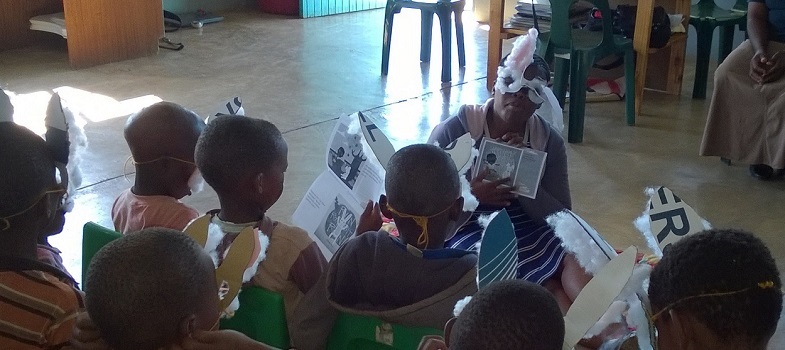Finding a good storybook
Most children love any story. We want children to have good storybooks so they learn to love telling stories and reading.
You can find many storybooks using the African Storybook Reader app. In the next activity you will use this app to find a story and then decide if it is a good storybook for your children.
Before you do the activity follow these steps to download and get started with the African Storybook Reader app:
Download the free African Storybook Reader app from Google Play or the App Store. Install the app on your phone or tablet.
- Go to EXPLORE to find storybooks to save in your LIBRARY.
- On the EXPLORE page, choose a language. Tap in the white spaceat the top of the screen to open the Language list. You can also open the Language list in the MENU (tap on the three dots at the top right of the screen).
- Select the language that you want for storybooks.
- The App will list all the storybooks in the language. You can organise the list by TITLE (alphabetically), by DATE (when it was published) or by READING LEVEL. You can search the list of storybooks by typing a key word or words.
A downloadable resource [Tip: hold Ctrl and click a link to open it in a new tab. (Hide tip)] on how to get started with the African Storybook Reader app is available from Downloads: additional resources on the course content page.
Activity 3.9 A good storybook
- Find any storybook using the African Storybook Reader app.
- Read the story to yourself or out loud.
- While you are reading, write down some reasons why you think this is a good storybook, or not a good storybook.
- Share your ideas with your colleagues, discuss together and make a list of what you think makes a good storybook for young children.
- Read our list in the discussion. Did you have anything different on your list? What would you add to your list now?
View discussion – Activity 3.9:
Discussion
A good storybook:
- is enjoyable.
- is authentic because it relates to children's contexts and realities.
- has good illustrations that support the text, and that may also suggest other meanings or feelings and extend the text.
- is not necessarily ‘real’ but is logically developed. In other words, make believe that is believable or nonsense that makes sense.
- has interesting language – rhyme, rhythm, repetition, word play.
- has suspense (or danger) to encourage children to say, ‘What will happen next?’ or ‘What if…?’
- has something unexpected, against the rules, or a ‘twist in the tail’.
- has a beginning, middle and end.
In the next activity you will practise using these criteria so that you can become an effective critical reviewer of storybooks.
Activity 3.10: Which stories do Children enjoy?
- Choose another storybook of your own or in the African Storybook Reader app. Download a copy of this table or copy it in your notebook and use it to review the storybook.
| Name of storybook: | |
|---|---|
| This storybook… | Review comment |
| Is enjoyable because… | |
| Is authentic because… | |
| Has good illustrations such as… | |
| Is logically developed because… | |
| Has interesting language like… | |
| Has suspense (or danger) when… | |
| Has something unexpected when… | |
| Has a beginning, middle, end | |
When you have a chance, read the same storybook to children. How will you know if they enjoyed the story? Ask them questions such as:
- a.What was your favourite part of the story?
- b.Which pictures did you like/what did you like about them?
- c.Which part of the story made you feel happy/angry/surprised, etc.?
- d.Which word is most interesting for you?
- Now you know what the children think about the storybook, would you choose to read it with them again? Why/why not?
As you read more storybooks, you will get into the habit of critically reviewing them by using the criteria in Activity 3.10. Also listen to your children. Let them tell you why they did or didn’t like a story. This will help them to choose books as they become fluent readers.
Songs and action rhymes for reading



